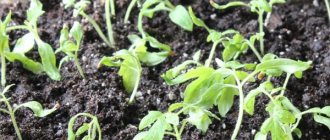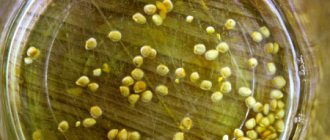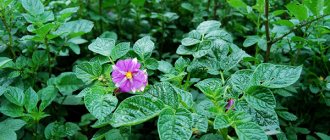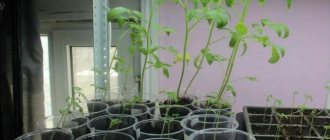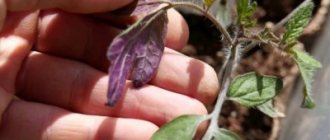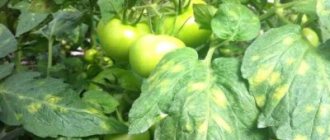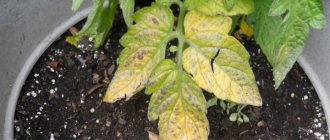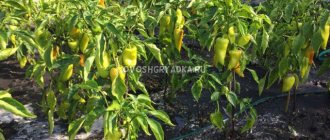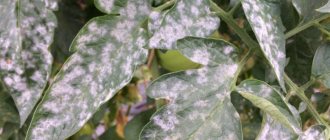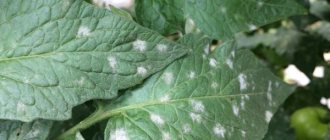Vegetable growing » Tomatoes
0
3572
Article rating
Kira Stoletova
If previously purple tomatoes were considered a curiosity and could be found very rarely, today they are found quite often not only in greenhouses, but also in open ground. Purple and black tomatoes have many advantages over red and yellow varieties. Not only the skin, but also the flesh is colored in an unusual color. The shade can vary from light chocolate to purple, almost black.
Varieties of purple tomatoes
General information
Purple-colored tomatoes (as well as black ones) require special attention. There are no exact instructions, but there are certain measures that are best followed. The purpose of purple tomatoes and all dark varieties of tomatoes is dietary nutrition. Therefore, when growing them, there is no need to use chemicals, and it is better to add organic matter rather than minerals as fertilizers.
Tomatoes with a deep purple or blue color similar to eggplant are believed to be medicinal. They owe these properties to a large number of anthocyanins, which determine their color. In terms of healing properties, such fruits are even compared to blueberries or red wine. This is an excellent anti-inflammatory drug necessary for the treatment of diseases of the digestive organs and diabetes. In addition, the substances in such tomatoes have a beneficial effect on the human body as a whole.
If you taste these tomatoes, you understand that they differ favorably in taste from other varieties. Most likely, taste is the main reason for the increased demand for dark and purple tomatoes, which are presented in quite a wide variety.
Where did the Lilac Fog tomatoes come from?
According to experts, this variety of tomatoes has its roots in Holland. A similar hybrid was obtained by crossing a domesticated tomato with its wild varieties. With these experiments, scientists tried to create a tomato variety that would contain an increased amount of antioxidants. Such substances have a positive effect on the human body as a whole, improving its sense of self. This substance is also responsible for the unusual coloring of tomatoes, which is unusual for Russian residents.
The experiment lasted quite a long time, but the results obtained were simply stunning. A gene was discovered in the Lilac Mist tomato that prevented the breakdown of chlorophyll in the vegetable, and this was another reason for the purple coloration on the tomato. However, gardeners, as well as consumers who often purchase this or other exotic varieties, should keep in mind that the Lilac Fog hybrid does not contain genetically modified microorganisms.
On a note! The Lilac Fog tomato is in very high demand among the Russian population precisely because of the uniqueness of its properties, their usefulness, as well as special taste qualities, distinguished by their peculiar shades.
What's special?
Consider, for example, “lilac lake”. This is an early ripening tomato variety. It has the following characteristics:
- semi-determinate;
- medium height – from 130 to 150 cm;
- universal in purpose;
- the color of the ripe fruit is brownish-burgundy;
- flat-round in shape;
- weight from 200 to 350 grams.
Dark varieties of tomatoes, especially purple tomatoes, can satisfy even the most demanding tastes. However, you should be careful, as unscrupulous entrepreneurs often invent hybrid varieties and package everything in a row.
To avoid such tricks, you need to approach everything with knowledge and special attention. It is better to give preference to trusted manufacturers and a well-known variety included in the register.
In principle, purple tomatoes, like dark varieties, are no longer a curiosity. Today they are grown not only in greenhouses, but also in open ground. Both the skin of the fruit and its pulp are colored in an unusual color. The shade varies from light chocolate to purple-black.
What to do?
The temperature regime is quite easy to normalize .
If these are seedlings on a windowsill, place foil under the box and increase the daytime temperature in the room to 18°C. If the plants have changed color after being planted in the ground in the greenhouse, then it would be a good idea to put a heater in the greenhouse until the air temperature returns to normal.It also happens that after planting seedlings in the ground, an unexpected cold snap occurs. Refer to grandma's good ways. During a sudden cold snap, summer cottages of the last century were dotted with three-liter cylinders. By placing the balloon on the seedlings, a greenhouse effect was created. At one time, these little tricks helped save seedlings even from light frosts.
- Soil nutrition .
The case when the temperature regime is normalized, but the leaves do not restore their green color, indicates that there is not enough phosphorus in the soil, or it has become insoluble. These causes can be corrected by using ready-made nutritional formulations that are balanced in mineral content. Moreover, you can fertilize both the soil itself and the bush itself by spraying. For your information. It is recommended to fertilize tomatoes with phosphorus 1-2 weeks before planting seedlings in the ground. This will give the bushes the opportunity to adapt to a new place and when the temperature drops, the seedlings, although they will change color, will not die. - Apply fertilizers carefully. Oversaturation with phosphorus can negatively affect the growth of tomatoes.
The most popular product among gardeners is superphosphate fertilizer. It's also suitable for more than just tomatoes. For open ground, use a dry mixture, which is applied once every 2-3 years in spring or autumn before digging the soil. 40 grams is enough for one square meter. For seedlings, it is better to use fertilizer in liquid form. To do this, 20 grams of fertilizer are diluted in 10 liters of water and left for 24 hours.For foliar feeding, gardeners recommend liquid fertilizers, such as Agricola. 1 spoon is diluted in five liters of water. It is not recommended to exceed the indicated dose to avoid leaf burns. Spray in the morning and evening in cloudy weather. Necessary microelements are absorbed through the leaves.
- Fertilizers should not be applied during cold weather.. In order for fertilizers to be fully absorbed by plants, the air temperature should be around 18°C.
To prevent phosphorus from turning into solid form and being absorbed by tomatoes, the soil is limed with chalk, dolomites, and lime. In the fall, organic matter is added: compost, humus. Green manure improves the composition of the soil qualitatively. The Baikal-M product will help greatly. Microorganisms turn soil into black soil. It can be used at all stages of tomato growing.
- Tomatoes love slightly acidic or neutral soil .
In addition to superphosphate, the following fertilizers are also recommended: Double superphosphate, Ammophos, Ammophoska, Nitrophoska, Potassium monophosphate. As well as natural fertilizers, which are applied in the form of compost: humates, bone meal, feather grass, hawthorn, thyme. Granular fertilizers are applied directly to the roots. Phosphorus is best absorbed when it has been in the ground for about 3 years. - It is not difficult to normalize the light regime of plants . Choose a south window. Build screens from foil and use special LED lamps in addition to this.
Why does this color scheme exist?
Many gardeners, and even ordinary people, often have a question: “Why are tomatoes purple and why are they so good?” This shade in tomatoes appears due to the coloring pigments with which they were enriched during the process of creating the species. In red varieties, these are lycopene and carotenoids, and in blue varieties, these are the same anthocyanins that were bred in tomatoes through a long process of selection. As a result of complex manipulations, the tomatoes turned purple and acquired positive qualities:
- unusual and balanced taste;
- the ability to cleanse the human body of toxins (the merit of anthocyanins);
- an excellent choice for sauces, pickles and tomato juice;
- mid-ripening of varieties;
- high resistance to most diseases.
Planting tomatoes in open ground and care
This variety of tomato must be planted in open ground or placed in greenhouse conditions at the end of May or beginning of June, when the last frosts have gone. However, the time of disembarkation directly depends on the climatic conditions of a particular region, so this aspect also needs to be given attention.
Basically, agrotechnical actions on the part of the gardener are not very different from caring for other varieties of tomatoes:
- constant watering;
- periodic loosening;
- removal of emerging weeds;
- fertilizing with various mineral fertilizers;
- carrying out preventive measures for various diseases.
As a rule, the “Lilac Fog” tomato should have no more than a few stems; all the rest should be removed as unnecessary. If some leaves have formed in the form of brushes, then they must be eliminated, since they will attract all the incoming nutrients.
Since this variety is quite tall, and the fruits as a whole can pull the plant to the ground, it is worth installing special pegs to maintain this plant in a normal position.
Minuses
Are there any disadvantages? Hardly ever. These varieties are perfectly adapted to local weather conditions. It is able to withstand light frosts and bear fruit until late autumn. But there is one peculiarity - after rolling into jars, dark tomatoes lose their hue and lean more toward red.
When highlighting some varieties of purple tomatoes, it is worth focusing on “purple cognac”. These tomatoes have beautiful raspberry-red fruits. The tomato is large and fleshy. Its weight reaches 400 grams. Tall bushes, up to 1 meter in height. In terms of productivity, the variety is recognized as one of the best. Ripening period: 108-115 days.
Tomato diseases
Despite the fact that nature initially endowed this tomato variety with good immunity to various diseases, it is still worth taking preventive measures, since tomatoes that are less resistant to harmful bacteria and insects can be grown along with this plant. Spray the plant with a solution of boric acid, as well as potassium permanganate or iodine.
You can also use special preparations aimed at combating fungal growths and viruses, but first carefully study the instructions for use.
Knowledge and benefits
Residents of Western Europe are no longer surprised by the colors of vegetables and do not ask why tomatoes are purple and whether the human body needs them. It is no coincidence that blue tomatoes are a must-have product on supermarket shelves, and special attention is paid to the selection of such species. The fact is that blueberries, rich in anthocyanins (useful protective substances), are eaten extremely rarely by humans. And he won't eat much of it.
Tomatoes, as well as their processed products, can be consumed daily for therapeutic purposes.
The blue-fruited variety Blue Tomato has dark purple or blue fruits, almost like eggplants. He is of American origin.
These tomatoes also come in red-purple color. They have soft pink juicy flesh. The average weight is 130 grams. Tomatoes are great for making salad. Housewives also love to use them in conservation. This variety has a high degree of productivity. The plant is tall and needs shaping, as it has one stem. In terms of ripening time, this is an average tomato.
Blue-green tint only below
This is a sign of a lack of nutrients:
- magnesium;
- potassium;
- nitrogen;
- zinc
Lack of components slows down growth and reduces yield. Deficiency can be determined by the tops. Usually the purple color on the bottom of the leaf appears due to a lack of phosphorus.
If this problem occurs, you need to spray the leaves with water-soluble superphosphate. The procedure is carried out in the morning or evening, when there are no bright rays of the sun.
We invite you to watch a video on how to help tomatoes whose bottom part of the leaf has turned blue:
Particularly famous species
What a purple tomato looks like, the photo below illustrates this. However, do not forget about the wide variety of varieties. So it is not possible to show everything in this article.
The most popular among them:
- "purple cognac";
- "vessel";
- "fairy";
- "pumpkin".
Such varieties as “Jasper”, “Cherokee” and “bumblebee” “blue dragon” are well known. For example, the last of them has an interesting bush structure. Blue dragon tomato fruits look like plums and are collected in clusters. Popular dark varieties include:
- "black cherry";
- "purple jasper";
- "idol".
“Black Cherry” is popular with those who love sweet, miniature cherries. The fruits of this variety look like dark, purple berries. The weight of the tomato is barely 35 grams. The variety is absolutely universal, with high taste, rich aroma, and resistance to cracking during heat treatment. These tomatoes have high yields, form many clusters and are indeterminate. Stepchildren are mandatory for them. You need to leave one stem. In terms of ripening time, the variety is classified as medium.
“Purple Jasper” was bred in China and ripens in open ground. The eastern variety has taken root perfectly in our latitudes. The fruits are like small watermelons. This tomato is suitable for salads, for table decoration, for stuffing and, of course, for canning. The plant is tall and also requires formation into one stem. It needs to be tied up. The productivity of the variety is high. Its ripening period is at an average level.
Characteristics of the variety “Lilac Fog”
Each gardener decides for himself absolutely independently whether to grow a similar variety of tomatoes or not. However, to make such a decision, it is necessary to weigh and evaluate the advantages and disadvantages of this type of tomato.
The advantages of this variety include the following:
- bright shade of the fruit, which immediately attracts attention;
- variety of uses of tomato in cooking, since it is good for fresh cooking, and is also suitable for various types of thermal treatments and canning;
- high yield, which reaches 3 kg of tomatoes from one bush;
- this variety is unpretentious in care, it ripens quite early and at the same time you can see several fruits at the same time on one branch, however, it is necessary to harvest the crop before the onset of cold weather;
- This tomato can be stored for a long time, so many gardeners note that the remnants of the harvest are used as ingredients for New Year's dishes;
- The Lilac Fog tomato has good immunity to a variety of diseases, as well as pests.
Perhaps the only disadvantage of this variety is that it is completely unsuitable for making juices. It is also quite difficult to determine ripeness in the first stages of growing a hybrid. Otherwise, based on reviews from gardeners, no shortcomings were found in this species.
Fruit characteristics
As for blue tomato varieties, they are generally endowed with decorative properties. Their fruits are green at first and then begin to turn blue due to exposure to sunlight. In some varieties, this color appears as if someone sprinkled blue snow on the berries, while in others, the fruits are intricately decorated in the form of purple spots and geometric shapes.
Indigo Rose tomatoes turn blue where the sun hits them, and on the other side they start out green and then turn burgundy. The flesh of this variety is red and sometimes dark pink. Tomatoes look very similar to plums. From a bush you can collect a whole bucket, or even more.
Causes
The content of the article
- Causes
- What to do, how to help Purple tomato seedlings, what to do: video
- The tomato seedlings turned purple. How to fix it: video
Purple coloring of tomato leaves and stems is normal in some cases. The reason for this is considered to be the peculiarity of the variety.
The leaves, stems and fruits of such plants have a characteristic purple color. Therefore, before purchasing seeds, you need to pay attention to the description of the variety.
If the reason for the unusual color is not the variety, you need to find another reason that led to the color change.
Healthy plants have a succulent stem with rich green leaves. The appearance of crimson and lilac spots on the leaves of seedlings, which become purple over time, indicates that the plants are not healthy.
The color of the stems and leaves of tomato seedlings can change in one day, or over a period of time.
The purple tint may not be immediately noticeable; sometimes the color changes gradually. At the same time, the stem of the plant changes its color, starting from the root, moving towards the top.
If measures are not taken to correct the problem, the purple leaves will soon shrink, wither, stick to the stems, and the shoots stop growing. The stems become brittle and stiff, the roots dry out and the seedlings die.
When an uncharacteristic color appears, the cause is first identified, and then certain measures are taken to correct the problem. You need to act immediately.
The main reasons include:
- a decrease or sharp increase in air and soil temperatures;
- insufficient lighting;
- lack of phosphorus in the diet;
- increased acidity or alkalization of the soil;
- insufficient or excessive watering at elevated air temperatures.
Any of the reasons can exist separately or be combined with another.
- When there is insufficient lighting, plants do not absorb phosphorus well and change their color from green to purple.
- When the air temperature drops to 15 degrees and the soil to 12 degrees Celsius, the sprouts become uncomfortable and begin to experience cold. Their growth slows down, nutrients are absorbed worse, and a lack of phosphorus appears, which is characterized by a change in leaf color.
- The same thing happens when the temperature rises above 40 degrees Celsius. The seedlings grow poorly, and the leaves on the reverse side, veins and stems gradually acquire a purple tint.
- Sometimes plants change color even with sufficient lighting and comfortable thermal conditions.
- If picking or transplanting seedlings was carried out in violation of the rules, then due to damage to the roots, the plants stop growing and change color. This can happen due to a lack of oxygen in the soil, increased acidity or alkalization of the soil, lack of or improper preparation of the soil before planting seedlings.
- Lack of moisture at high air temperatures or excessive soil flooding can also lead to discoloration of leaves and stems and slower growth of seedlings.
Cats can sometimes cause purple leaves to appear on the bottom of plants. They mark the territory, their urine gets into the container with the seedlings, the seedlings begin to change color and die over time.
Having determined the cause, measures are taken to correct the problem.
Recommendations for gardeners
As for the peculiarities of growing purple tomatoes, after choosing a variety, they begin to prepare the soil. Good fruiting of tomatoes will depend on the composition of the soil mixture. You need to take humus, compost and soil in equal proportions, mix, add a little wood ash. After the soil mixture is prepared, it is sifted and disinfected. This is necessary to ensure that there are no microorganisms left in the soil. It is advisable to keep the soil in a double boiler for up to 10 minutes, then the fungal spores will be destroyed. This procedure will also lead to the death of weeds.
To achieve better results, tomato seeds are germinated before sowing. They are placed in a napkin moistened with warm water and placed on a plate. Then carefully cover the seeds with the free end of the cloth. The plate with planting material is placed in a bag and placed in a warm place. In a few days they will germinate. The napkin should always be damp. If necessary, add warm water to it (a little to moisten it). After the sprouts appear, you can begin the planting process.
Having made grooves in the soil, the seeds are laid out with tweezers at a distance of approximately 1.5-2 cm. Having finished planting, they are sprinkled with earth. The soil is slightly compacted. After all, the soil is sprayed with a spray bottle. Do not water with a strong stream. Now the container with the seeds is covered with film and after 7-8 days the first shoots should appear. Then you can remove the covering material and allow the seedlings to grow naturally, helping them with watering and lighting.
The purple color of the fruits of tomatoes has nothing to do with the color of the seedlings. It should be normal green. Having planted some varieties of tomatoes, many gardeners, noticing that the tomato seedlings are purple, begin to worry. This is typical for inexperienced farmers. They cannot understand why young tomato seedlings are purple, what is the reason for this manifestation?
After all, a change in color is a signal that negative changes are happening to the plant already at the initial growth phase. Then the purple seedlings begin to wither and emit an unpleasant odor.
What to do if tomatoes take on such shades?
There are several ways to improve the condition of tomatoes. Which one to choose depends on the reason for the appearance of the blue or purple tint.
Control of temperature and lighting mode
Seedlings are usually left indoors. There should be a temperature of 25 degrees. After the emergence of seedlings, the indicator is reduced to 20 during the day, and to 16 at night. If a purple color appears, the seedlings are transferred to a warm room.
In case of insufficient lighting, seedlings are moved closer to a source of natural light. Phytolamps will also help, especially at the beginning of development. Daylight hours should be 10–12 hours.
Fertilizer application
The lack of phosphorus is compensated by watering with solutions of phosphorus fertilizers. Fits:
- superphosphate;
- ammophos;
- nitroammophos;
- nitrophos.
Any product should be diluted according to the instructions specified by the manufacturer.
Wood ash is effective. It is simply scattered over the soil in which tomatoes grow, or a solution is prepared. You will need ash and hot water (1 liter each). After infusion for 24 hours, you need to add warm water (3 liters) and laundry soap (15 g). The liquid is used to spray plants.
Soil preparation
Seedlings are grown in light, fertile and loose soil. Universal primer is suitable. It contains all the necessary components, including phosphorus. Such soil ensures normal development of the plant.
